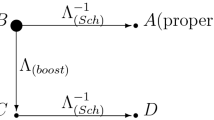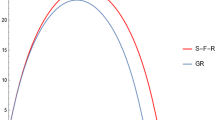Abstract
Recently, a new method to simplify calculations in teleparallel theories has been put forward. In this article, this method is improved and used to analyze the gravitational energy–momentum tensor (density) of the Schwarzschild solution in a frame that is arbitrarily accelerated along the z-direction. It is shown that, for a special type of frame, one cannot make the gravitational energy density vanish along the observer’s worldline, regardless of the observer’s acceleration. The role played by the frame and its relation to the observers’ worldlines are investigated. It is shown that, for the aforementioned special frames, the results for the gravitational energy and angular momenta are consistent with what we would expect.

Similar content being viewed by others
Notes
It corresponds to the Levi-Civita connection in the tetrad basis.
References
A. Einstein, Sitzungsber. Preuss. Akad. Wiss. Berlin (Math. Phys.) 1915, 778 (1915)
A. Papapetrou, Proc. R. Irish Acad. (Sect. A) 52, 11 (1948)
P.G. Bergmann, R. Thomson, Phys. Rev. 89, 400 (1953)
C. Møller, Ann. Phys. 12(1), 118 (1961)
L.D. Landau, E.M. Lifschitz, The Classical Theory of Fields, vol. 2, 4th edn. (Pergamon Press, Oxford, 1975)
S. Weinberg, Gravitation and Cosmology: Principles and Applications of the General Theory of Relativity (John Wiley and Sons, New York, 1972)
R. Aldrovandi, J. Pereira, Teleparallel Gravity: An Introduction (Springer, London, 2012)
J.W. Maluf, Ann. Phys. (Berlin) 525(5), 339 (2013)
K. Hayashi, T. Shirafuji, Phys. Rev. D 19, 3524 (1979)
Y.F. Cai, S. Capozziello, M.D. Laurentis, E.N. Saridakis, Rep. Prog. Phys. 79(10), 106901 (2016)
C.Q. Geng, L.W. Luo, Class. Quantum Grav. 34(11), 115012 (2017)
J.G. Silva, A.F. Santos, S.C. Ulhoa, Eur. Phys. J. C 76, 1434 (2016)
J.D. Brown, J.W. York, Phys. Rev. D 47, 1407 (1993)
J.W. Maluf, S.C. Ulhoa, J.F. da Rocha-Neto, Phys. Rev. D 85, 044050 (2012)
F. Hammad, D. Dijamco, A. Torres-Rivas, D. Bérubé, Phys. Rev. D 100, 124040 (2019)
J.W. Maluf, S.C. Ulhoa, Phys. Rev. D 78, 047502 (2008)
Y.N. Obukhov, J.G. Pereira, G.F. Rubilar, Class. Quantum Grav. 26(21), 215014 (2009)
J.B. Formiga, Ann. Phys. (Berlin) 530(12), 1800320 (2018)
S.S. Xulu, Int. J. Theor. Phys. 39, 1153 (2000)
T. Vargas, Gen. Rel. Grav. 36(6), 1255 (2004)
A.A. Sousa, J.S. Moura, R.B. Pereira, Braz. J. Phys 40, 1 (2010)
S.C. Ulhoa, J.F. da Rocha Neto, J.W. Maluf, Int. J. Mod. Phys. D 19(12), 1925 (2010)
H. Abedi, A.M. Abbassi, S. Capozziello, Ann. Phys. 405, 54 (2019)
J.B. Formiga, Ann. Phys. (Berlin) 532(3), 1900507 (2020)
J.B. Formiga, The meaning of torsion in teleparallel theories (2020) arXiv:2004.10788v2
J.B. Formiga, V.R. GonSalves, Mod. Phys. Lett. A 36(18), 2150125 (2021)
Author information
Authors and Affiliations
Corresponding author
Ethics declarations
Conflict of Interest
The authors declare that they have no conflict of interest.
Additional information
Publisher’s Note
Springer Nature remains neutral with regard to jurisdictional claims in published maps and institutional affiliations.
Appendix
Appendix
1.1 Applying the Hybrid Machinery to Eqs. (42)–(45)
In this appendix we give the torsion tensor, the superpotential, the torsion scalar, and the quantity \(\Sigma ^{\lambda \mu \nu }T_{\lambda \mu \alpha }\) in terms of the tetrad given by Eq. (24) with \(\{\hat{t}_\lambda ,\hat{s}_\lambda ,\hat{\phi }_\lambda ,\hat{z}_\lambda \}\) given by Eqs. (42)–(45).
By inverting Eqs. (42)–(45), we get
We can simplify the calculations by using the following definitions:
Substituting Eqs. (42)–(45) and (60) into Eqs. (28)–(31), we obtain
To write the torsion components in terms of \(\{\hat{t}_\lambda ,\hat{s}_\lambda ,\hat{\phi }_\lambda ,\hat{z}_\lambda \}\), we use Eqs. (57)–(60). From these equations, one can check that
By substituting Eqs. (66)–(71) into Eqs. (62)–(65) and simplifying, we find that
Substituting these equations into Eq. (27) and manipulating the result yield
Rearranging the terns on the right-hand side of Eq. (76), one can verify that \(2T^{[\mu|\lambda|\nu]}=T^{\lambda \mu \nu }\).
From Eqs. (72)–(75), it is possible to show that
Using these equations, Eq. (27), and the definition \(T_{\nu }=T{^a}{_{a\nu}}\), we obtain
From this expression and Eq. (32), we find that
Finally, by substituting Eqs. (82) and (76) into Eq. (2) (remember that \(2T^{[\mu|\lambda|\nu]}=T^{\lambda \mu \nu }\)), we arrive at
To calculate the gravitational angular momentum density, we need the component \(\Sigma ^{a0b}\). From Eqs. (83), (61), and Eqs. (38)–(41), we obtain
where we have used the identities \(fh_{16}-gh_{18}=({\partial }{_z}g)/(fB)\), \(fh_{15}+gh_9=2fh_6\sin \theta\) and \(gh_{19}-fh_9=2gh_6\sin \theta\).
To evaluate \(\Sigma ^{\lambda \mu \nu }T_{\lambda\mu\alpha}\), it is convenient to proceed in the following manner: Let X, Y, and Z be elements in \(\{\hat{t}{^a},\hat{s},\hat{\phi },\hat{z}\}\); assume that X is different from both Y and Z. From the orthonormality condition, we see that
We can use this identity to obtain, after a lengthy calculation, the expression
Contracting \(\nu\) with \(\alpha\) and using (61) to eliminate \(h_{18}\) and \(h_{16}\), we find that
Rights and permissions
About this article
Cite this article
Formiga, J.B. Revisiting the Gravitational Energy of the Schwarzschild Spacetime with a New Approach to the Calculations. Braz J Phys 51, 1823–1832 (2021). https://doi.org/10.1007/s13538-021-00975-8
Received:
Accepted:
Published:
Issue Date:
DOI: https://doi.org/10.1007/s13538-021-00975-8




